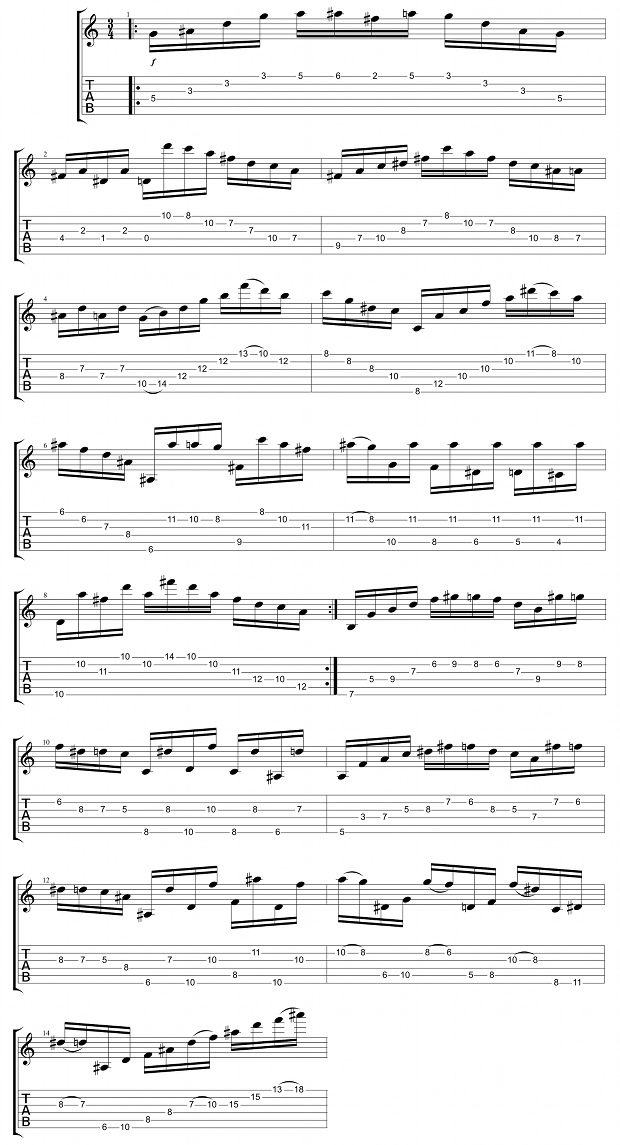Learning Paganini's 16th Caprice in G Minor
Learning classical pieces like this one is a great way to improve your technique and theory.

A while back, I posted a short, 30-minute guitar workout designed for guitarists whose practice time is limited.
The positive response I received prompted me to create an additional lesson, which, in combination with my original workout, will give you a good hour of intensive practice.
For this lesson, I have selected a classical piece for you to learn: Paganini's 16th Caprice in G minor. Learning classical pieces is a great way to improve your technique and theory. It's also more beneficial to practice something musical, rather than just working on exercises.
Use my 30-minute workout as a warmup and then spend an additional 30 minutes to an hour working on this piece. It's very challenging and features a good selection of arpeggios, wide intervals, chromatic runs, string skipping and sequences. It's very rewarding to learn and play in its entirety.
Because of its length, I have the divided the piece into three parts. Your first task will be to memorize the notes, which in itself is a big challenge. I would suggest taking it one bar at a time, memorizing the notes and working out the fingering. Then attempt to perform the bar in full. Start at the beginning with bar 1, and add a new bar every day.
Once the notes are memorized, you can begin to work with a metronome and build speed. Start at 80 bpm playing 8th notes and increase the metronome by 10 bpm after each successful performance.
When you reach 120 bpm, go back to 60 bpm and play the piece as 16th notes. From there, take it as fast you can. It's meant to be at a tempo of 165 bpm, which is incredibly fast for a piece so complex. I can only get to around 120 bpm before it becomes too challenging. For this lesson, I have recorded myself performing the piece in full at the comfortable tempo of 100 bpm. Use this as a reference for yourself when learning. I have also marked in the Soundcloud link where each of the three parts begins to help you navigate.

The first part begins with several arpeggios which you will need to play using sweep picking (bars 1 to 6). Everything else should be played with alternate picking. There's a tricky string skipping section at bar 7, which you can either play with your second finger or entirely with the pick. After bar 8, it repeats from the beginning.
From bars 9 to 14, you have more arpeggios and string-skipping, but this time you will not need to sweep the arpeggios. Bar 14 ends with a long A# major arpeggio over three octaves. Next week, we will look into detail at the second part of the piece and also analyze some of the theory used in its composition. Best of luck!
Will Wallner is a guitarist from England now living in Los Angeles. He recently signed a solo deal with Polish record label Metal Mind Productions for the release of his debut album, which features influential musicians from hard rock and heavy metal. He also is the lead guitarist for White Wizzard (Earache Records) and in 2012 toured Japan, America and Canada. Follow Will on Facebook and Twitter.
Get The Pick Newsletter
All the latest guitar news, interviews, lessons, reviews, deals and more, direct to your inbox!
“There are so many sounds to be discovered when you get away from using a pick”: Jared James Nichols shows you how to add “snap, crackle and pop” to your playing with banjo rolls and string snaps
Don't let chord inversions bamboozle you. It's simply the case of shuffling the notes around







![Joe Bonamassa [left] wears a deep blue suit and polka-dotted shirt and plays his green refin Strat; the late Irish blues legend Rory Gallagher [right] screams and inflicts some punishment on his heavily worn number one Stratocaster.](https://cdn.mos.cms.futurecdn.net/cw28h7UBcTVfTLs7p7eiLe.jpg)


